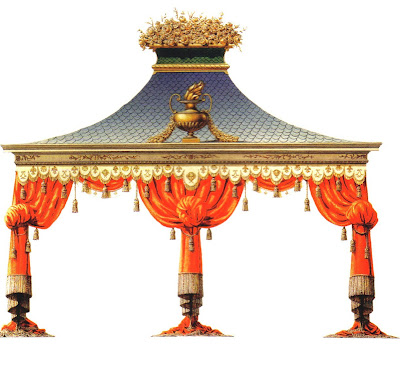
I just spent the weekend reading Chinoiseries by Bernd H. Dams and Andrew Zega (Rizzoli New York, 2008), a book which has generated a great deal of buzz in the blogosphere. And I just couldn't not write about it- the book is too stunning and in my opinion deserves all of the praise that it receives.
The book is a compilation of architectural watercolors of 17th and 18th c. Chinoiserie follies and pavilions in France. Rendered by Dams and Zega, the colorful paintings capture the exuberance and charm of these architectural gems. To the authors, these buildings represent "the architecture of joy". And joy is what Dams and Zega give to the reader.
Some of the buildings featured in the book were never built; the authors based their renderings on historical documents. Sadly, most of the structures that were built have been destroyed. That is such a tragedy, but I suppose we can take solace in the fact Dams and Zega have preserved the legacy of these buildings, if at least on paper.
Tartar Tent at Parc Monceau; built c. 1775. Commissioned for the Duc de Chartres, this structure was later destroyed.
Chinese Tent for Trianon Versailles. Conceived by the workshop of Jean-Baptiste Pillement in 1780, this tent, never built, was possibly designed for Marie-Antoinette's gardens at Trianon.
Refreshment Tent for Versailles. Another project that was never built, this charming tent was designed in 1779; the architect is unknown.
The Pagoda at Rheinsberg. One of the book's few non-French examples, this pagoda was built for Prince Heinrich of Prussia around 1765. Located at Heinrich's palace at Rheinsberg, Germany, the pagoda is sadly no longer standing.
(All images from Chinoiseries by Bernd H. Dams and Andrew Zega, Rizzoli New York, 2008)
Home » Garden Follies » The Architecture of Joy
The Architecture of Joy
5:37 AM
apa ya
Labels:
Books,
chinoiserie,
Garden Follies






No comments:
Post a Comment